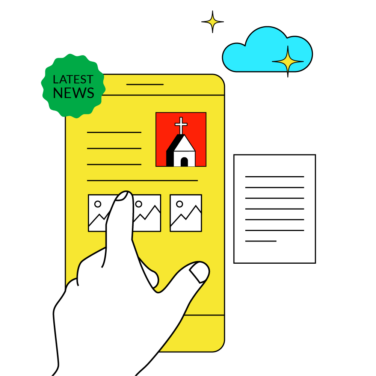When we talk about church leadership, we’re not just talking about running programs or organizing volunteers. We’re talking about the sacred work of developing other Christlike leaders - men and women who care deeply for people and lead them toward Jesus.
But building that kind of leadership culture isn’t always simple.
- You might be juggling way too many responsibilities because your current leaders aren’t empowered to lead.
- You may have plenty of people serving, but few who are truly shepherding others.
- Or, you’re stuck trying to figure out how to structure your leadership so ministry doesn’t fall apart the moment you take a week off.
These problems often come up when our leadership structures are more about filling roles than forming people. Leadership, at its core, isn’t about getting more help—it’s about growing more healthy, Spirit-led leaders who disciple others.
God's most precious resource is His kids.
Joshua GOrdon
With that lens, church leadership is much less about task management and much more about people development.
In this guide, we’ll explore the biblical foundation for church leadership, how different leadership roles work together, and practical principles to help you build the kind of leadership team your church actually needs.
In this article, I’ll cover:

What Is Church Leadership?
The Great Commission (Matthew 28:16–20) commands us to make disciples, and discipleship requires leadership. But what is church leadership?
Church leadership includes two key areas:
- The people who guide and oversee the church (often called the leadership team).
- The actions that reflect Christ’s love to the world, such as outreach, service projects, and teaching ministries.
In this article, we’ll focus mainly on the leadership team, but both areas work together to fulfill God’s mission. That being said, here are key truths about church leadership:
- Every Christian is called to lead. As 1 Peter 2:9 reminds us, we are all part of the “royal priesthood,” responsible for sharing Christ’s light.
- Leadership shapes how the church is seen. Whether it’s a pastor preaching, a deacon serving, or volunteers leading ministry, the world forms its view of the church through our leadership.
- Healthy leadership happens at every level. From the pastor to small group leaders, everyone has a role in shepherding others toward spiritual growth.
Leadership is critical - especially when it comes to starting a new ministry. At its heart, church leadership means overseeing and shepherding God’s people. That could like a bunch of different things (discipling youth, managing church projects, setting church record management policy, etc...)
The specific shape of leadership may change depending on the role, but the purpose stays the same: to glorify Christ and disciple others.
The church that is not jealously protected by mighty intercession and sacrificial labors will before long become the abode of every evil bird and the hiding place for unsuspected corruption. The creeping wilderness will soon take over that church that trusts in its own strength and forgets to watch and pray.
AW Tozer
Roles And Responsibilities Of Church Leadership
Every leadership role in the church exists to serve one core purpose: shepherding people toward Jesus. Whether that’s through preaching, planning, or managing, our goal isn’t just to get things done or cross tasks off a to-do list... it’s to help people grow.
Scripture lays out two roles that are 'umbrellas' for how most churches today are structured: elders (or pastors, shepherds, and overseers), and deacons (assigned managerial responsibilities.
Elder/Pastors/Overseers
- Oversees the spiritual direction of the church and preaches regularly.
- Acts as the shepherds for the congregation (1 Peter 5:2–3).
- Provide spiritual oversight and ensure that the church remains doctrinally sound (Titus 1:5–9).
- Offer pastoral care and mentor other leaders in the church.
- Help mediate conflicts and make key decisions on church direction.
Deacons
- Focus on serving the physical and logistical needs of the congregation (Acts 6:1–7).
- Organize practical ministries like benevolence, hospitality, facility upkeep, etc.
- Assists pastors and elders by lightening their workload.
Inside these two functions in Scripture, I can find a handful (or two!) of leadership roles, ordered by responsibility, most of which can be found in most churches. These roles often overlap, and their responsibilities can vary depending on your church’s size and needs.
Remember: the goal isn’t just filling roles—it’s forming leaders who shepherd others well. Titles don’t build the church; people do. (Ephesians 4:11–13).
1. Senior Pastor
The senior pastor provides spiritual direction for the church through regular preaching and shepherding the congregation (1 Peter 5:2–3). As the church’s primary leader, they represent the ministry in the community and cast a vision that aligns the church’s efforts with its mission.
2. Executive Pastor
The executive pastor manages church operations, overseeing staff, budgets, and administration to ensure ministry goals are met. Acting as a bridge between spiritual leadership and practical planning, they support the senior pastor and handle day-to-day responsibilities.
3. Worship Leader
Worship leaders plan and lead biblically centered services that engage and inspire the congregation (Colossians 3:16). They coordinate music, media, and other elements of worship while equipping musicians and volunteers to serve effectively.
4. Youth and Children’s Ministry Leaders
These leaders disciple young people, helping children grow without shame through Bible studies, events, and outreach activities. They also build strong relationships with parents to support family discipleship and foster intergenerational faith development.
5. Small Group Leaders
Small group leaders create environments for discipleship and fellowship within smaller gatherings. They provide pastoral care, accountability, and a welcoming space for members to grow spiritually and connect with others in the church.
6. Church Administrators
Church administrators handle the logistical side of ministry, managing communication, church event planning, and finances. They also maintain facilities and coordinate staff and volunteers to ensure the church operates smoothly.
7. Mission and Outreach Coordinators
These leaders oversee outreach programs to serve the local community and beyond, encouraging evangelism and training members to share their faith. They also manage partnerships with missionaries or service organizations to expand the church’s Kingdom impact.
8. Hospitality and Volunteer Coordinators
Hospitality coordinators welcome new visitors, helping them feel connected to the church family. They organize volunteer schedules, provide training, and cultivate a culture of service and belonging within the congregation.
The Best Church Management Tools for Your Church:
These church management tools can bring structure and streamline the nuts-and-bolts of your various ministries. Check ’em out:
Attributes Of Church Leadership
The best church leaders don’t just get the job done—they point people to Jesus. It’s not about being impressive; it’s about being Christlike. That’s what makes a true leader.
- Servant-Hearted (Mark 10:45):
- Leaders must prioritize others’ needs over their own.
- A servant’s attitude builds trust and unity within the church.
- Spirit-Filled (Acts 6:3):
- Leaders should rely on the Holy Spirit for wisdom and strength.
- A Spirit-led life fosters humility and discernment.
- Teachable (Proverbs 9:9):
- A leader who is open to learning (and can handle criticism) will continue to grow spiritually and practically.
- Teachability helps leaders adapt to the needs of their congregation.
- Integrity (Titus 2:7–8):
- Leaders must model honesty and moral character in every aspect of life.
- Integrity strengthens the church’s witness in the community.
- Good Communicator (Ephesians 4:29):
- Clear, compassionate communication prevents misunderstandings.
- Leaders must share God’s truth in ways that inspire and equip others.
- Devoted to Prayer (1 Thessalonians 5:17):
- Prayer anchors leaders in God’s will and aligns their hearts with His.
- A prayerful leader strengthens the spiritual life of the church.
- Empowering (Ephesians 4:12):
- Leaders should equip others to step into their God-given callings.
- An empowering approach builds a stronger, more engaged church body.
- Resilient (2 Corinthians 4:8–9):
- Ministry challenges are inevitable; resilience keeps leaders grounded in faith.
- A resilient leader inspires others to persevere in their walk with Christ.
How do we cultivate these things? We spend daily time in Scripture and prayer. We seek mentorship from other experienced church leaders. And, we encourage accountability and feedback from trusted team members.
Related Read: Church Volunteer Management Guide: Strategy, Tips, & Software
Different Forms Of Church Government
Church government is often responsible for shaping church leadership within a denomination or local church body. Generally speaking, there are three main types of episcopal, presbyterian, and congregational.
Episcopal Church Structure
In an episcopal structure, bishops hold authority in the church, providing guidance, support, orthodox theology, and even discipline when necessary. The bishop oversees (Greek episkopoi means “overseer”) a local diocese—a region of churches. In this way, local churches hold accountability to the diocese, and the diocese is accountable to the bishop who represents the diocese worldwide.
Presbyterian Church Structure
The word 'Presbyterian' is drawn from Greek word presbuteros, meaning 'elder' (coincidentally, it's also the place where we draw the word “priest” from). In a presbyterian church government structure, there are four levels of church governance.
- The first level is led by elders elected from the local church in session (aka the governing council). The lead pastor (commonly called 'the teaching pastor') acts as moderator. The elders appoint and oversee deacons (servant leaders), assigning specific tasks and responsibilities within the local church. Deacons are generally considered to be models for the other members to follow.
- The second level is called 'the presbytery'. Like the diocese in an episcopal structure, presbyterian church government organizes all elders within a geographic region.
- The third level is the 'synod' - a larger governing council composed of a group of several presbyteries.
- The fourth layer of presbyterian structure is the 'general assembly'. This national body is a gathering of elders from many synods that makes big-picture determinations for the church overall.
Congregational Church Structure
Congregational governance emphasizes the independence of the local church, allowing each body to make its own decisions on doctrine, theology, and practices. This decentralized approach entrusts key responsibilities to the congregation itself.
Key Features of Congregational Governance:
- Autonomy: Churches are self-governing, making decisions without oversight from a higher authority.
- Democratic Decisions: Members vote on major issues, such as leadership selection and budget approval.
- Local Leadership: Pastors, elders, and deacons are chosen and held accountable by the congregation.
- Biblical Basis: Rooted in the priesthood of all believers (1 Peter 2:9) and local church autonomy (Acts 14:23).
While empowering and flexible, congregational governance requires spiritual maturity and a strong commitment to biblical principles to thrive.
Key Principles Of Church Leadership
Effective church leadership is built on timeless principles found in Scripture and serves the needs of the congregation.
1. Prayerful Dependence on God (Philippians 4:6)
Prayer is the foundation of effective church leadership. Leaders must seek God’s guidance in every aspect of ministry, from decision-making to daily responsibilities. A consistent, Spirit-led prayer life demonstrates reliance on God and sets an example for the congregation to follow.
2. Equip and Disciple Others (Ephesians 4:12)
Leadership isn’t about doing all the work but empowering others to serve and grow. By training, mentoring, and discipling church members, leaders raise up new workers for ministry and foster spiritual maturity throughout the congregation.
3. Set Jesus-Centered Vision (Proverbs 29:18)
A church thrives when its leaders articulate a clear, Gospel-centered vision that inspires and unites people. Transparent communication ensures the congregation understands the church’s mission and feels aligned with its goals, creating trust and shared purpose.
4. Model Christlike Servanthood (Mark 10:45)
Christlike leadership is rooted in humility and service. Leaders must prioritize the needs of others and lead by example, demonstrating love, sacrifice, and a willingness to serve the body of Christ in both small and significant ways.
5. Act with Accountability and Integrity (1 Timothy 3:1–7)
Church leaders must uphold biblical qualifications to maintain moral authority and credibility. Seeking accountability from mentors and peers helps leaders stay grounded in their faith and committed to their calling, ensuring they lead with integrity.
Final Thoughts
Remember, church leadership isn’t about perfection—it’s about faithfulness. Stay grounded in God’s Word, lean on His guidance, and lead with a servant’s heart. Through your obedience, God will equip you to make an eternal impact.
Keep going—you are making a difference!
Join Our Email List
If you found these insights helpful, don’t miss out on more resources like this! Subscribe to my newsletter for practical tips, biblical encouragement, and tools to help you thrive in church leadership.
Join today. We'd love to have you.


